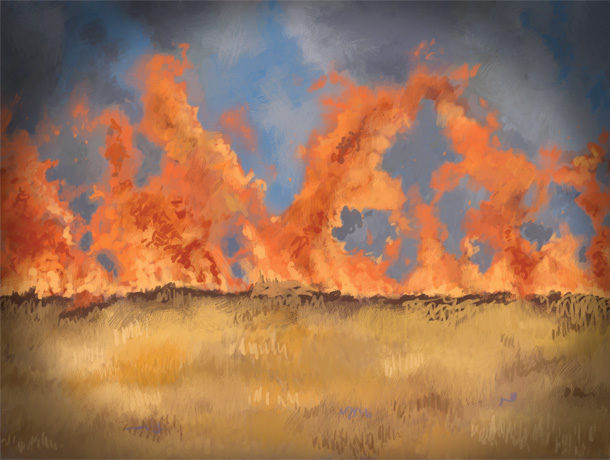If you don’t want a raging grass fire, you have to plan. To get a controlled fire that burns the CRP grassland without making the local newspaper takes planning and preparation. I learned the hard way that tossing a match without planning doesn’t end well. The same goes for transition planning.
Transition planning is a bit like a pasture burn. It can either be effective and routine or really exciting and out of control. When transition planning is out of control, bad things happen, and people get hurt. Relationships and bridges get burnt.
My first grass burn was a disaster. It wasn’t that I was reckless; it’s just that I didn’t know how and didn’t understand the power of large grass fire. Unmanaged conflict during a transition plan looks like a raging wildfire. It’s white-hot, blown by the winds of change and out of control. Unfortunately, conflict often engulfs estate and transition planning. It’s usually no one’s fault but just a lack of planning and process. Lighting a match and hoping for the best can lead to disastrous results.
Transition planning is best when there is a plan in place before starting. It is often the first real test of a family farm’s ability to have deep discussions about important topics. Conflict, and the fear of conflict, is a significant reason why too many transition plans fail.
There will be differences of ideas and visions that will arise during a transition. It’s normal. Differences of opinion are not necessarily bad. But sometimes it’s necessary to clear the air and get everyone’s thoughts out on the table. Just like a controlled prairie fire is needed to remove the dead grass, volunteer trees and weeds while creating fertile soil for new grass to germinate, low-level productive conflict allows new ideas to sprout.
The key is preparation.
- Don’t wait: Tackle any emotional issues before the raw emotions become the issue. Procrastination has rarely solved tough problems. If there is a bad marriage, bad blood, chemical dependency or past wrongs, deal with them or make amends. A clean slate is your fire break for conflict.
- Personal perspectives: Discuss each other’s personal goals, values and concerns. Learn and understand what is important to each other. You don’t have to agree with each other; just understand where people are coming from. (Don’t forget to include any spouses.)
- Code of conduct: Agree on a common set of behaviors, attitudes and beliefs that are important to the success of the family farm. We recommend this is written down and reviewed at least each year. Some of our clients review this quarterly as a reminder.
- Visions: Discuss the goals and vision for the farm and the personal vision of the key players. It’s often assumed everyone is on the same page because “we are family.” The best way to keep a family strong is to discuss and document the visions. It may seem complicated, but essentially, it’s answering the question of “Where do you want to end up?” This step is not easy or quick, so take your time. If you need help facilitating this discussion, get it. While personal visions don’t have to align directly, the farm vision should. Farm vision is one area where a near consensus is needed to move forward with the transition plan.
There was a day when my grass fire was out of control with flames 15 feet high. Before it was all over, the local fire department, the Minnesota State Highway Patrol, sheriff and most of the neighborhood were involved. Trees were burned, telephone poles were blackened, and I made the local paper. It was embarrassing. We still burn because it is important for a healthy CRP, but today we create boundaries and fire breaks instead of trusting to chance. We plan ahead and take our time.
The steps outlined above are your fire break and your water. If you plan ahead and take your time, your transition plan will be a mild event that brings great results for your family and a lasting legacy.











